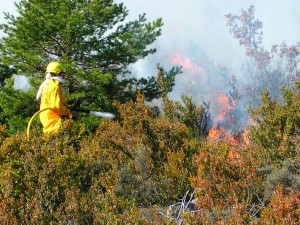 Understory shrubs play an important role in forest functioning as they may compete with overstory trees for soil resources and increase the risk of fire propagation. Moreover, shrub encroachment into grassland may decrease pastoral value and increase fire hazard to surrounding forests. However, shrubs may have value as a fodder resource or alternative biomass energy, and shrub formations may have non-marketable values as C sinks or biodiversity hot-spots. Thus, forest managers are increasingly interested to develop strategies to manage the multifunctional benefits of these formations in a context of global change. Management for all these goods and services simultaneously may require tradeoffs in most cases. This research aims to contribute to provide knowledge and tools for the management strategies and decision process. The overall aim of this research is to gain knowledge on shrub responses and effects on soil and ecosystem function after disturbances caused by these different management activities. Specifically, this research line addresses the following objectives:
Understory shrubs play an important role in forest functioning as they may compete with overstory trees for soil resources and increase the risk of fire propagation. Moreover, shrub encroachment into grassland may decrease pastoral value and increase fire hazard to surrounding forests. However, shrubs may have value as a fodder resource or alternative biomass energy, and shrub formations may have non-marketable values as C sinks or biodiversity hot-spots. Thus, forest managers are increasingly interested to develop strategies to manage the multifunctional benefits of these formations in a context of global change. Management for all these goods and services simultaneously may require tradeoffs in most cases. This research aims to contribute to provide knowledge and tools for the management strategies and decision process. The overall aim of this research is to gain knowledge on shrub responses and effects on soil and ecosystem function after disturbances caused by these different management activities. Specifically, this research line addresses the following objectives:
– To determine the mechanistic drivers of the response of different functional shrub types to management disturbances
– To understand the trade-offs between different management techniques and shrub formations
– To estimate how contrasting management practices affect ecosystem function, including pastoral value and soil fertility
– To define key processes for modelling ecosystem changes associated to different management options
Related Projects:
Forest Understory Prescribed Burnings: Effectiveness and Constraints (ForBurn). Ministerio de Ciencia y Economía (MINECO). AGL2012-40098-CO3-00. 2013-1015.
GHG-Europe. Greenhouse gas management in European land use systems. European Comission. EU-RTD integrated project. VII FP. 2010-2013.
VULCA. Vulnerabilidad del C edáfico al cambio climático y de uso del suelo en ecosistemas pastorales: Efectos del cambio en el régimen de precipitación en pastos abandonados o quemados. Ministerio de Educación y Ciencia. 2006-2008.
Selected related papers are:
Valor T, González-Olabarria JR, Piqué M, Casals P. 2017. The effects of burning season and severity on the mortality over time of Pinus nigra ssp. salzmannii (Dunal) Franco and P. sylvestris L. For. Ecol. Manage. doi:10.1016/j.foreco.2017.08.027
Casals P, Valor T, Besalú A, Molina D. 2016. Understory fuel load and structure eight to nine years after prescribed burning in Mediterranean pine forests. For. Ecol. Manage. 362,156-168
Montané F, Casals P, Dale MRT, 2011. How spatial heterogeneity of cover affects patterns of shrub encroachment into mesic grasslands. PLoS ONE, in press.
Martí-Roura M, Casals P, Romanyà J, 2011. Temporal changes in soil organic C under Mediterranean shrublands and grasslands: Impact of fire and drought. Plant and Soil, 338, 289-300 doi: 10.1007/s11104-010-0485-0
Montané F, Romanyà J, Rovira P, Casals P. 2010. Aboveground litter quality changes may drive soil organic carbon increase after shrub encroachment into mountain grasslands. Plant and Soil, 337, 151-165. Doi: 10.1007/s11104-010-0512-1
Montané F, Casals P, Dale MRT. 2010. Spatial patterns of shrub encroachment in neighbouring grassland communities in the Pyrenees: floristic composition heterogeneity drives shrub proliferation rates. Plant Ecology, 211, 267-278 Doi: 10.1007/s11258-010-9788-8
Montané F, Casals P, Taull M, Lambert B, Dale M R T, 2009. Spatial patterns of shrub cover after different fire disturbances in the Pyrenees. Annals of Forest Science, 66:612
Casals P, Romanya J, Vallejo VR 2005. Short-term N2 fixation by legume seedlings and resprouts after fire in Mediterranean old-fields. Biogeochemistry, 76(3): 477- 501
Romanyà J, Casals P, Vallejo VR 2001. Short-term effects of fire severity on soil nitrogen availability in Mediterranean grasslands and shrublands growing in old fields. Forest Ecology and Management, 147: 39- 53